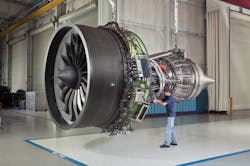It’s probably going to be a while till the first GEnx's roll into the shop for a major makeover, “six-plus years before it comes in for its first performance-restoration … visit,” says Tom Levin, General Electric’s general manager for the GEnx and CF6 product lines.
Here’s the skinny on the shape and scope of what to expect when preparing to maintain these fuel-efficient, built-to-last powerplants.
Market penetration
The penetration of this relatively new family of engines is expanding rapidly. The GEnx-2B entered revenue service in 2011 on a Cargolux Boeing 747-8; the GEnx 1B started propelling passengers in April 2012 under the wings of a Japan Airlines Boeing 787.
As of mid-May 2014 GE says there were some 289 GEnx-2Bs and 183 GEnx-1Bs in service. As of mid-May the -2Bs had racked up 1.3 million flight hours; the -1B had accumulated 449,000. Those last two sets of numbers translate into 243,000 and 93,000 cycles respectively.
Then there’s this number, the one that counts most: departure reliability is 99.9 percent.
“We ran over 30,000 factory test cycles and flight test cycles before the product ever entered into service,” says Levin. “We firmly believe that our customers don’t want to test the engines for us, so we do that for them. We identify any issues” beforehand.
Teething problems
As with virtually any new powerplant there are teething problems. A 2012 airworthiness directive, “involved the fan midshaft” according to GE. “This involved inspections on the -1B and -2B engines.” Operators are complying.
The Federal Aviation Administration issued an airworthiness directive – effective Jan. 7, 2014. This AD was “prompted by the original equipment manufacturer’s disclosure that certain life-limited parts (LLP) used in Boeing 747-8 flight tests had consumed more cyclic life than they would have in revenue flight cycles.” The AD’s summary went on to require a “one-time adjustment” to the LLP’s to account for the added low cycle fatigue life consumed during flight tests. The FAA says it issued the AD “to prevent failure of critical rotating LLPs, uncontained engine failure, and damage to the airplane.”
A Nov. 27, 2013 airworthiness directive required revision of the flight manuals for 747-8s, 747-8Fs, and 787-8s powered by GEnx engines. The change alerts flight crews to potential ice crystal icing (ICI) conditions at high altitudes, and prohibits operation in moderate and severe ICI conditions. “This AD also requires inspecting the engine after any ICI event is detected by the flight crew. This AD was prompted by reports of engine damage and thrust loss events as a result of flying in high altitude ICI.” The AD aims at ensuring “crews have operating instructions to avoid flight into ICI conditions that can lead to engine damage and thrust loss.”
United Airlines’ Senior Vice President of Technical Operations Ken Burtt says, “In comparison to other engines United has introduced in the past, the GEnx has been a reliable engine so far.” He says the carrier’s GEnxs (the longest-lived of which has accumulated some 4,600 hours of operation) “have not undergone any major shop visits or overhauls” as of this writing.
UA has 55 more seven-eights on order, including not just -8s, but -9s and -10s as well.
Despite the ADs, GE’s Tom Levin contends, “For a product with the advanced technologies that we’ve introduced here, to have that level of reliability right out of the gate is really unprecedented.”
Pedigree
Consider the components GE has packed into this powerplant. “There are key elements of technology and architecture of the engine that we derived from the GE90,” says Levin. “But I wouldn’t describe the GEnx itself as a ‘derivative’ of the GE90.” To underscore the fact, “There aren’t common part numbers.” The new engine’s part’s pool is GEnx-specific.
What you will notice is that the GEnx, like the GE90, sports Blisks. The life-limited part integrates rotor disc and engine airfoils all in one component. The move is aimed at saving weight and boosting efficiency. The key difference is that the GEnx’s Blisks are resident in the Stage 1, Stage 2, and Stage 5 components. Levin says, “We’re developing technology … to perform repairs on the airfoils to maintain the life of these parts.”
Preparing to maintain the GEnx
The GEnx is suffused with new materials. And that means “new repair technologies,” says Levin. In addition to the expanded use of Blisks, the fan blades are composite carbon fiber. So’s the fan containment casing and other material throughout the fan module.
More exotica: GE introduced T-aluminide (a titanium/aluminum alloy) into the low-pressure turbine. “It saves about 200 pounds per engine,” says Levin. “When this material comes into the shop, it’s not going to be your grandmother’s repair scheme.” He says GE is “working actively to develop” such a repair capability.
That capability is going to be carried out in what Tom Levin terms “a competitive MRO landscape,” one that includes multiple players. “We believe that competition drives continuous improvement in cost of ownership. It drives efficiency. It’s better for our airline customers.”
To that end, GE is setting up a network of GEnx shops, shops he says “will compete against GE, to be frank, for maintenance business.”
There should be plenty of maintenance to go around once these powerplants ripen up for shop visits. There are some 400 GEnx’s out there just now. This year alone, Levin says the company will produce 300, making for 600 operating engines worldwide by the start of 2015. Levin labels this, “the fastest widebody ramp-up of any product in our history, and really the industry’s history … [It’s] huge.”
Huge too is the number of projected GEnxs flying around by 2020. In a scant six years the engine’s general manager says there will be some 2,000 of them.
To repair all those new-generation thrust-making machines, by the end of 2014 GE will sport three of its own facilities: GE Caledonian in Scotland, GE Celma in Brazil, and a joint-venture set-up involving GE and Evergreen, sited in Taiwan. The latter will be capable of doing GEnx maintenance by the end of this year says Levin.
Interestingly, there is – at present – no GEnx overhaul capability in North America. But there are GE facilities in Cincinnati and Dallas “able to provide line maintenance services and lighter workscopes for quicker turnaround.” Levin says the engine OEM is looking “very closely” at establishing a partner shop in North America.
But execution of engine overhaul for the GEnx is also dependent on licensed liaisons with a growing string of MROs worldwide. Abu Dhabi Aircraft Technologies and Air France/KLM are part of the independent network of shops.
It’s in GE shops and affiliated MROs that long-term performance is woven into the fiber of the GEnx. The mechanics of the process can only be taught by close cooperation: “How you maintain clearances in the compressor. How you restore the airfoils to maintain their aerodynamic efficiency,” says Levin. Such is the level of technical know-how that GE is sharing with its partners “so that they can provide the same level of quality that you can get from a GE shop.”
Instead of bringing overhaul technicians into its home-base in Cincinnati to learn the arts associated with the new powerplant, Levin says, “For those that are going to tear the engine down into piece parts, or perform component repairs – the more extensive workscopes – we actually send training teams on-site to help these guys develop the proficiency they need.”
In light of the projections for this potent powerplant’s sales there’s going to be a need for lots of proficiency in plenty of places.





